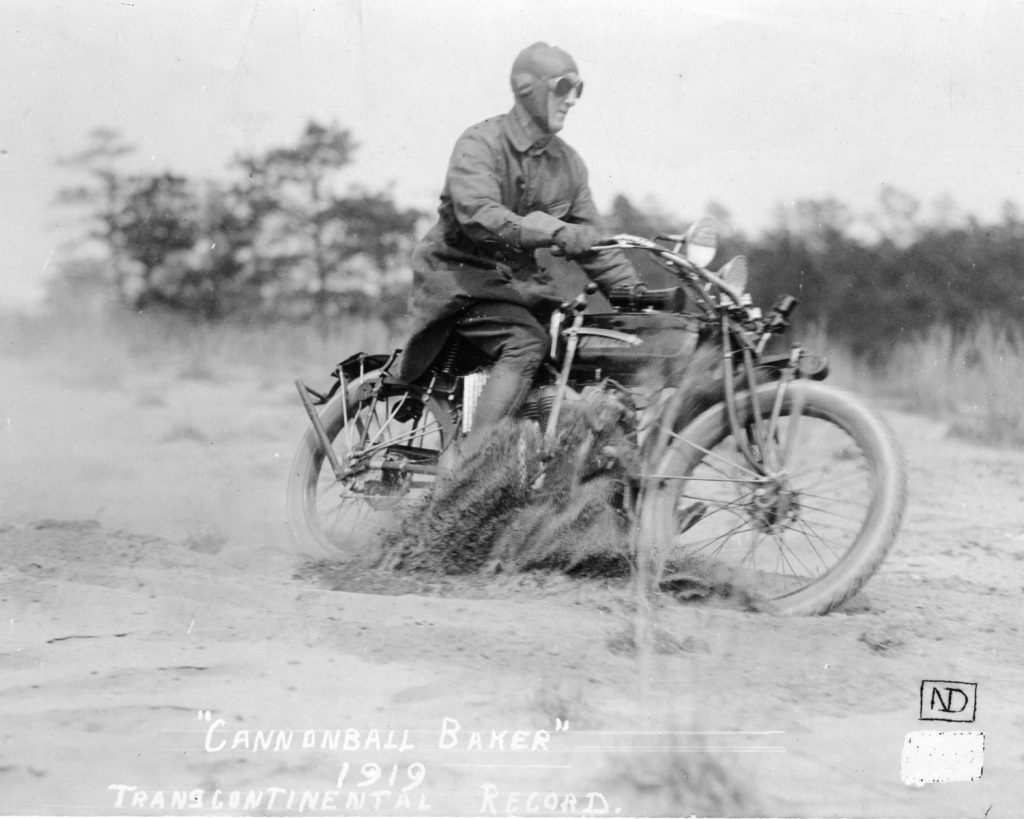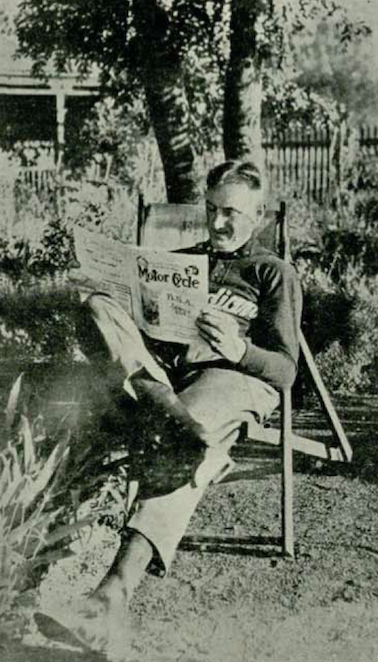American legend Erwin ‘Cannonball’ Baker enjoyed a remarkably long life for someone who parlayed a job testing motorcycle tyres for the Indianapolis Tyre Company into a full-time career as an endurance rider.
In 1914, after a 14,000 mile ride through Florida, Cuba, Panama and Jamaica, he planned to set the transcontinental motorcycle record from San Diego to New York. He was mounted on a 7hp Indian Hendee Twin fitted with 3-inch section tyres with steel plate under the crankcases, and carrying a one-gallon water container. Baker packed a .38 Smith & Wesson to shoot wild dogs as he rode through Indian country, but that wasn’t the only threat to his attempt. He suffered 100 degree temperatures, desert sand drifts, rain storms, muddy unmade roads and hallucinations from lack of sleep.
After 11 days, 12 hours and 10 minutes Baker arrived in New York having covered 3378.9 miles. The press immediately dubbed him ‘Cannonball’ after the Illinois Central Express. He was very much in demand, tackling every type of challenge he could, driving cars, trucks and motorcycles on record attempts for manufacturers usually on a ‘no record, no money’ basis.
What’s little known is that in 1915, Cannonball visited Australia on a promotional tour for his sponsor, Indian Motor Cycles. At the time Australians were largely wedded to British singles of which there was a shortage due to the outbreak of war. The era of the big twins had come, and large numbers of American bikes were being imported. Cannonball arrived with his record breaking Indian Twin and the latest 1916 model, the plan being to capture all the Australia inter-city records.
Only a few days after he arrived in Sydney, he completed an incredible ride to Melbourne in 18.5 hours. This was merely a reconnaissance of the route for the planned record attempt, yet it would take years for an Australian to better Cannonball’s time. He continued on to survey a 33-mile road course around the backblocks of Mortlake, Victoria. It was over this course that Cannonball set a new world record of 930 miles for a 24-hour ride, despite the fact that the bike caught fire at a refuel stop early in the attempt. At the 750 mile mark, Cannonball hit a boulder and was delayed for almost three hours while a local blacksmith welded the frame.
Upon his return to the USA Cannonball commented, “It was the toughest ride I ever took. I got my worst punishment the time I was petrified in Australia. That is the only word I can think of to describe it. I hung up a new 24-hour record at Mortlake. From one o’clock in the morning the rain came down in buckets. My leathers were soaked to the consistency of messy glue. After the rain stopped, the hot January sun turned on all its burners. Riding in a cramped position crouched low over the handlebars, my leathers began shrinking and getting tighter. After a few hours I was literally baked into what had become a suit of armour. When they lifted me off the cycle at the end of the run, I was as rigid as a mummy and they had to cut me out of the suit.”
The Indian advertising slogan of ‘SPEED, STRENGTH, STAMINA’ could easily have been applied to Baker himself for, a few days later, he made a second attempt, this time covering 1028 miles in under 22 hours before the bike’s oil tank ruptured, ending the attempt. When word of his stoppage reached the control point, spectators ran to the bike and found Cannonball asleep on the ground.
In addition to the 24-Hour record, Cannonball had set over 15 records in a single ride, including 300 miles in six hours, 576 miles in 12 hours, 876 miles in 18 hours and 1000 miles in 21 hours 2 minutes. Is it any wonder that on the return trip from Down Under, Baker stopped at Honolulu and set new records for a ride around the island.
Here with an image of Baker in Australia reading ‘AMCN’s’ predecessor (featured on the cover of that magazine in February 2016). Lots of other images available. Google ‘Cannonball Baker’.

Baker on another record attempt in 1919, and below, reading about his own exploits

Words Peter Whitaker











